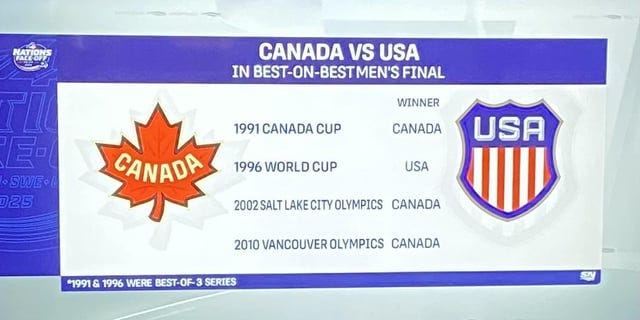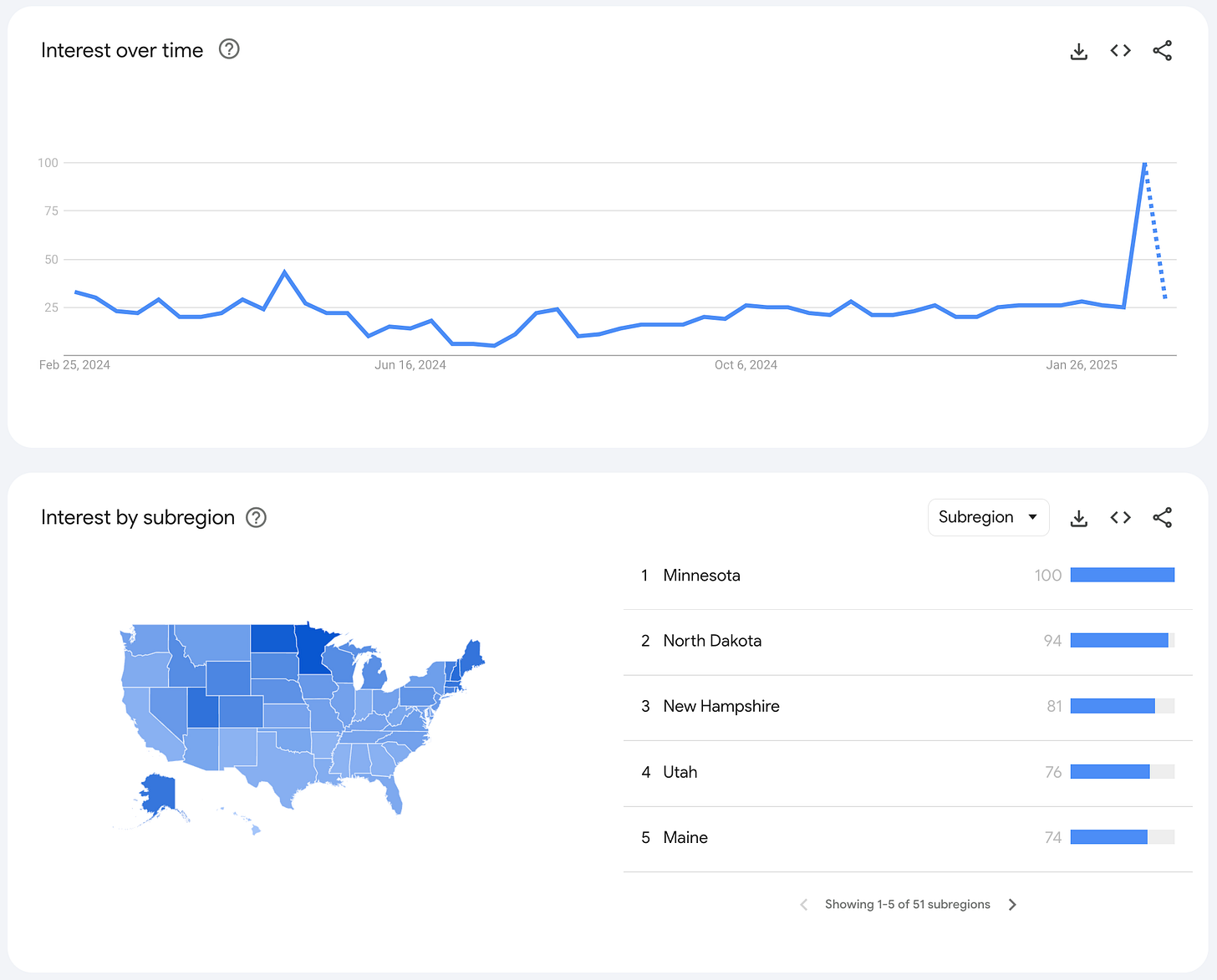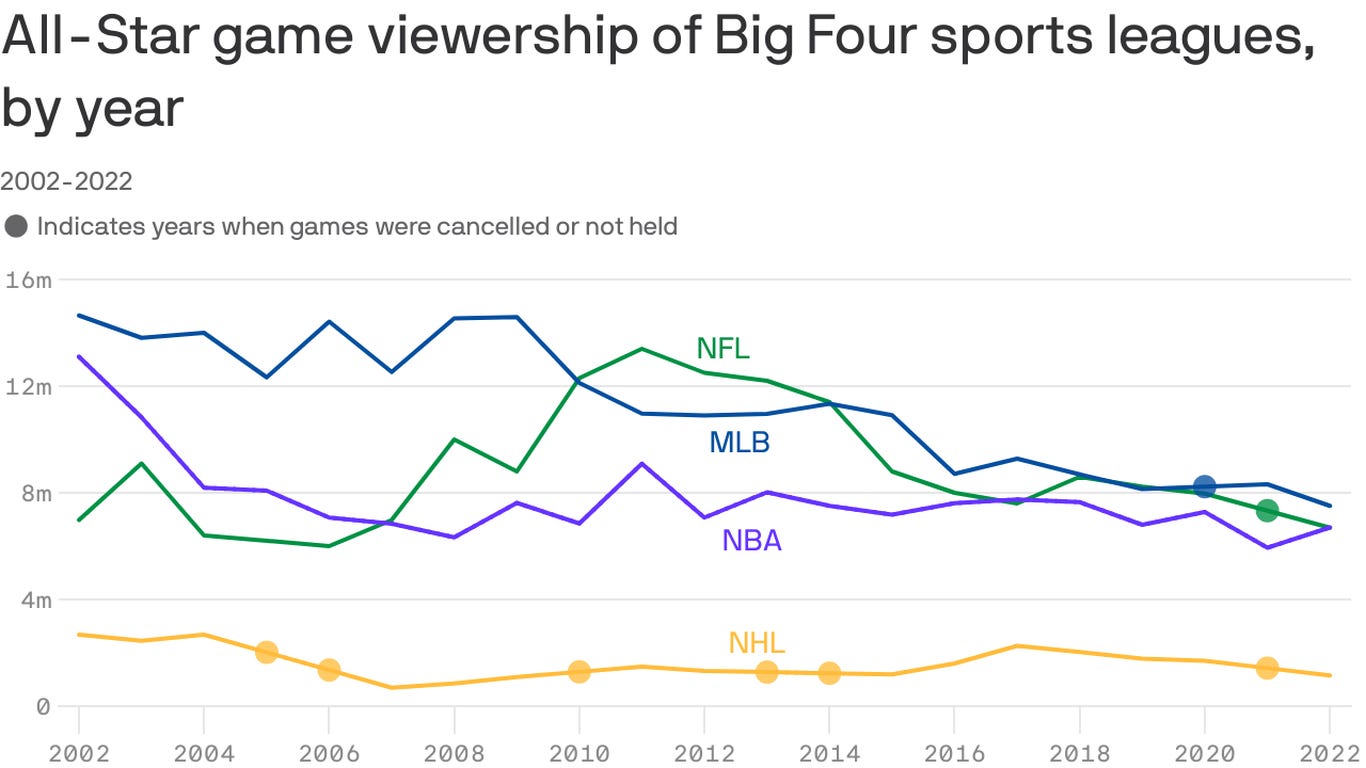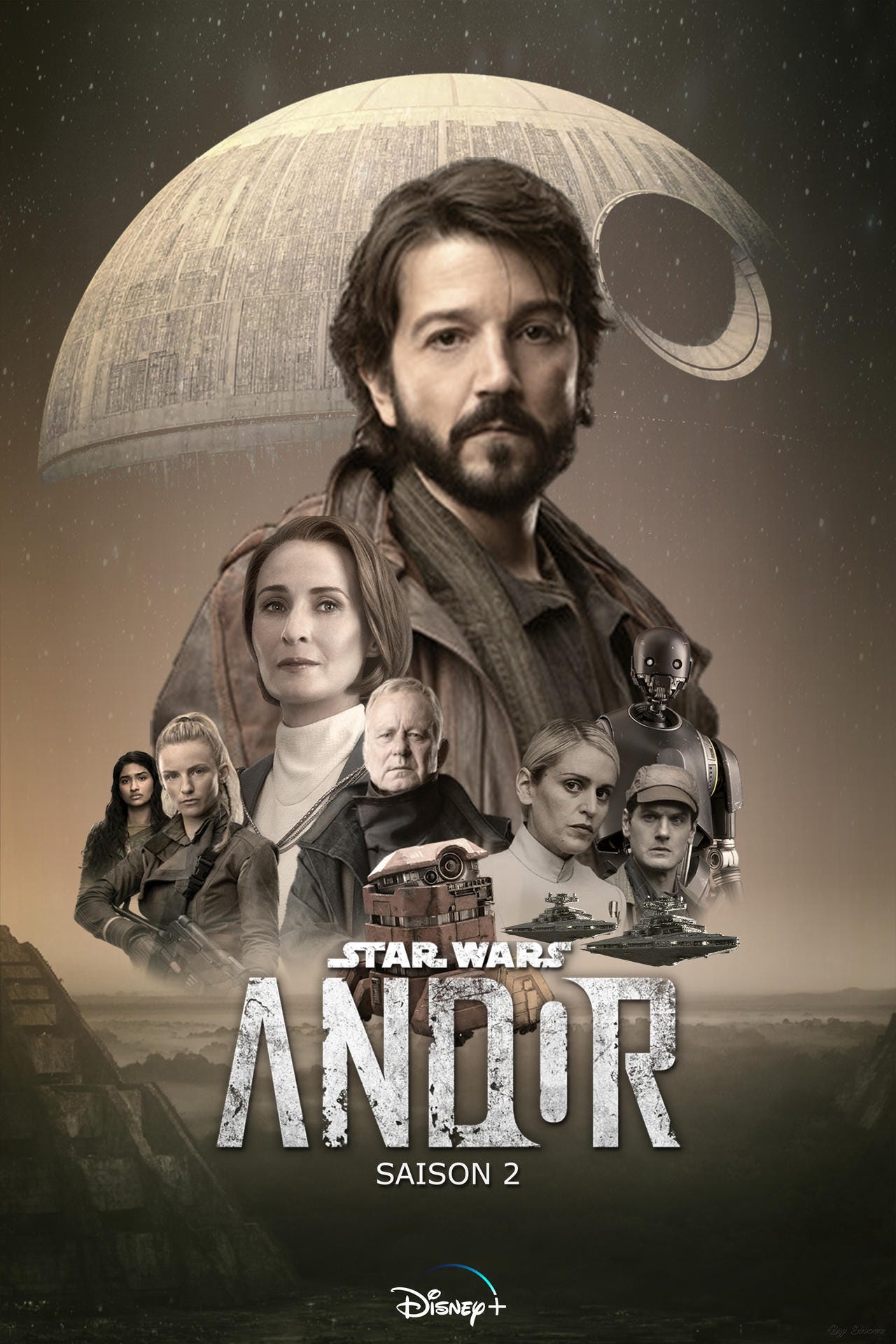The NHL (mostly) Nailed It. What Now?
Recapping the mayhem, the mercilessness, and the magic of the NHL Four Nations Face-off before we look at what's next
Long ago, the four nations lived in harmony. Then everything changed when the NHL signed the Four Nations contract… or at least a modern North American ice hockey war started brewing.
I was fortunate enough to watch the 2025 Four Nations both in person at TD Garden in Boston, and with friends at home (although we struggled to stay up through the whole game with an 8:15pm ET puck drop). My wife and I watched much of the first game between the US and Canada by ourselves at home in Cambridge— with national anthem boos, gigantic hits and all. It was absolutely electric hockey and immediately clear that the tournament could live up to the hype thrust upon it. My wife was rooting for Canada while I was cheering on the US, and despite our brewing in-house rivalry, the initial games set the stage for a great mid-season NHL event.
The following Monday, we got to see the matinee Finland-Canada game in person at TD Garden here in Boston, which was admittedly a snoozer for almost 55 minutes, with the Canadian team taking advantage of some great fast break goals in an otherwise relatively sloppy game. The last 5 minutes were wild though, with 4 goals scored in very quick succession after the Fins pulled their goalie, which brought the arena to life. However, Canada’s win meant the evening game that Monday ended up being a relatively meaningless US-Sweden matchup unfortunately. Although I do think the overall tournament structure suffered a bit from having these last two round-robin matchups feel a bit stale, it really was special to watch so many stars of today’s NHL go all-out against each other in person.
On the flip side, the first and final US-Canada games absolutely made up for the lull, and provided some of the most exciting hockey I’ve seen in years. We watched the final game at home with a small group of friends who are not typically hockey watchers, let alone weeknight TV event watchers. The whole drama and performance of the game was super fun to follow, and even if we once again got exhausted after a couple periods, I’m definitely glad I got to watch it live to experience the excitement. I was potentially even more glad I didn’t try to pay up for record ticket prices at TD Garden too!
The whole event honestly felt like a mini winter Olympics, but the singular focus on one sport made it feel even more special and unified somehow— these few games were the main focus of national sports media for a week. And as it turns out, there were a LOT of fans tuning in as well. Over a quarter of the Canadian population (~10.7 million) watched the final game, and ESPN set its NHL game viewership record with over 9 Million concurrent viewers. Despite carrying team salaries between one-third to one-half of most MLB and NBA teams, the NHL achieved viewership for a mid-season tournament that rivaled the most recent NBA finals peak viewership of 13.2M on ABC.

There have been a wide variety of articles covering the potential factors that lead to the Four Nations’ explosive popularity, so I had to throw my hat in the ring to emphasize key points, and to highlight a few key points I haven’t seen voiced in detail elsewhere. I also wanted to take a brief step back to look at the broader professional sports scene and try to figure out what impact, if any, the success of this tournament means for other leagues and governing bodies. Finally, we have try to predict the future for the NHL itself, and figure out where they go from here, with the Four Nations potentially being a spark to light a bonfire, or just a flash in the pan.
As much as I would love to hone in exclusively on the quality of the play on the ice, I think the the current geopolitical climate in North America represents the clearest reason the Four Nations tournament gained so much momentum. Despite the constant comparisons, the tensions and monumental feats of this tournament didn’t rival the 1980 Miracle on Ice, where Kurt Russell led a team of actors to beat the USSR at the Olympics. However, Trump’s constant statements about making Canada the 51st state, an impending tariff war, and the booing of each others’ national anthems all added to the hype of the moment. Even US and Canadian leaders made their presence felt, with Justin Trudeau appearing in the stands in Montreal and Trump calling in to the US team locker room ahead of the final!
Pair this backdrop of heightened emotion with the first “best-on-best” hockey games crossing the North American border in over a decade, and the off-ice excitement reached a crescendo. Ahead of the Four Nations, I had not realized that Canada and the US hadn’t played their best (i.e. all NHL) players against one another in over a decade. The NHL stopped allowing its players to participate in the Olympics after 2018, and other international tournaments are extremely sparse at the pro level. This tournament represented the first time many young NHL super stars like Connor McDavid got to don their nations’ colors as a pro against the best players from other nations, and it also may have been the last for older players like Sidney Crosby. In many ways it felt like the passing of a torch for every nation.

If you think this all sounds like the most elaborate WWE storyline of all time, I agree. I also don’t think that’s a bad thing in the world of modern sports, especially when the play on the ice and the passion of the fans throughout the tournament made it all real…
To me, this authenticity was a core piece of what made the tournament worth watching. I cared a lot because the players and coaches themselves clearly cared a lot, and their drive was infectious. In almost every interview, coaches and players on each team constantly talked about how excited they were to represent their country, how fun and intense the games were, and how much they wanted to win it all. And it wasn’t just talk either— the games were absolutely electric and players were clearly going all-out, at least if three fights in the first ten seconds of a game are any indication!
This passion from the players, coaches, and existing fans ended up drawing in new audiences and sports media pundits to the games as well, which added even more excitement. Of course, there’s nothing more fun than telling someone else about one of your passions. There’s a low chance that we would have hosted friends for a meaningless, low-energy midseason all-star game in any sport including hockey, but for this tournament, the players on the ice cared, and so did we.

This overall flywheel of excitement started spinning even faster because of the stark contrast between the Four Nations tournament and the other star-studded midseason events in other leagues, particularly the NBA all-star weekend. The all-star formats for almost every league, but especially the NFL and NBA have been pretty universally maligned in recent years, and this year that seemed to reach a breaking point, with the tepid all-star skills challenge, a dunk contest won by a G-League player, and a mini tournament with no real defensive effort on display. I mean, who would want to pay big money to watch the leagues’ best actively not try at a skills competition (even if it is admittedly pretty funny):
The NHL clearly created a great format for the Four Nations, and was aided by a few chance occurrences like a new cross-border rivalry to launch an extremely successful event— but what were some of the potential downsides of this format? Well perhaps first and foremost, one of the greatest existential risks to all-star events was realized for multiple players and teams: long-term injury caused by play during the event.
Perhaps the biggest losers of the entire tournament were the Florida Panthers and Boston Bruins, despite the fact that Boston hosted the tournament and our captain Brad Marchand hoisted the trophy with Canada. Unfortunately, the Bruins’ star defenseman Charlie MvAvoy, and Panther’s star forward Matthew Tkachuk both sustained injuries during the tournament that will see them miss time for their teams. Of course, the Bruins are not happy, and in general NHL players are paid less than their counterparts in other sports and their overall individual impact is lower. If LeBron James or Patrick Mahomes suffered a major injury going all-out during an all-star or international team event, the financial consequences would be enormous. This fact alone does not stop sports like soccer from constantly letting their athletes play in international events, so perhaps there are underlying divergences that drive these differences in governance strategy and culture.
Second, I do think it’s worth zooming in on some more of the chance elements that helped really elevate this tournament to the highest heights. Most obvious is the geopolitical situation, but I do think novelty played an outsized role in making Four Nations popular: it was super fun to watch so many great players play against each other for the first time in years. There’s also the fact that almost every game in the tournament ended up being close and exciting at the end, which is certainly due in part to parity, and partially down to luck— look no further than this years’ Super Bowl to see how great teams matching up doesn’t always equal a close, exciting game. To cap it all off though, the US and Canada ended up back in the finals playing each other after their first game of insanity. If this same tournament format was played every year moving forward, I think it might lose some of its player engagement, and even with that, could have fluctuating excitement just based on chance outcomes alone. The NHL really did capture lightning in a bottle this year and should be commended for doing so!
So with all the good and the bad about the tournament, a couple core questions bubble back to the surface. First, how should other leagues react? As mentioned, major leagues in the US are struggling to make players, teams, and most importantly fans care about all-star events in the modern era. Since 2000, the viewership for almost every league’s all-star game has nearly halved, and while leagues like the MLB have tried to add incentives like World Series home field advantage, not much has seemed to stick.
Ironically, I think so many of the elements described above that made the NHL’s Four Nations tournament pop are not feasibly replicable in most other US leagues. The prospect of an individual country-based tournament within a league might only be possible in the MLB, and even then the US team would likely dominate. Abstracting to a US v. World format could be tempting in the MLB and NBA, but would not work well in the NFL. There are also very few solidified international rivalries in these sports, especially when compared to hockey or especially soccer, and it’s also worth re-highlighting that perhaps the NHL can get away with a full-gas all-star event midseason because the financial stakes are lower than for an NFL or NBA team, even if the chances of injury might be lower in those sports.

Without the specifics from the NHL’s version of this tournament format bleeding into other leagues’ all-star events, what is left to take away? Perhaps my most controversial take is that leagues should not host an all-star event every year or limit the amount of times a player gets to attend, which would introduce more novelty and excitement to each event. In many major leagues, the same players attend all-star events every year for over a decade, so for the players and the fans, the “newness” of the event drains quickly, especially when players aren’t incentivized to try hard and format tweaks don’t make a difference. You can of course add motivation for players by paying them to try hard, but I actually think there might just simply be a supply and demand problem for most all-star events right now!
And looping all the way back to the NHL, this might perhaps be the most important lesson to take forward as well. The NHL is set to allow its players in the upcoming 2026 Milan Olympics and plan to host the Hockey World Cup in 2028. These events may be just as politically charged as the Four Nations tournament, with the Russian team potentially making an appearance at both, and mean that there will definitely be International best-on-best hockey over the next three years. But in the interim years between these events that promise to be highly touted, what should the NHL do?
The NHL hasn’t made their plans clear yet, and I think another set of Four Nations tournaments might be white noise compared to these much larger international events. In my mind, the NHL can either revert to its regular all-star programming every year, or could perhaps even just put a pause on all-star festivities to concentrate focus on these larger international events, especially if they want to grow the game abroad. Or perhaps they should begin adopting an every-other-year cadence of all-star games with the Olympics cycle!
Pretty much every scenario is on the table and I don’t envy the people making decisions. Hockey as a whole has many other existential risks on its doorstep, with rising gear costs, apparel partnership struggles, and an unrealized struggle to break into the most valuable sports franchises list. However, when it comes to the midseason event format, I really want to emphasize how low demand is for bog-standard all-star events right now, and how a change in supply could really restore their value.
At the end of the day, I think I agree with the headline from Sportico author Eben Novy-Williams, that reads “That Hockey Tournament Was Great. We’ll Likely Never See It Again.” And that’s OK. I know that we love to ride anything that generates excitement and turns it into cash until the product can barely walk anymore, but I am hopeful that perhaps the NHL Four Nations tournament may end up like a great limited TV series: we loved it for what it was and it didn’t overstay its welcome.




